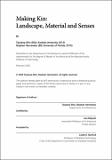| dc.contributor.advisor | Ana Miljacki. | en_US |
| dc.contributor.author | Shin, Taeseop. | en_US |
| dc.contributor.author | Hernandez, Stephan, | en_US |
| dc.contributor.other | Massachusetts Institute of Technology. Department of Architecture. | en_US |
| dc.date.accessioned | 2021-02-19T20:18:28Z | |
| dc.date.available | 2021-02-19T20:18:28Z | |
| dc.date.copyright | 2020 | en_US |
| dc.date.issued | 2020 | en_US |
| dc.identifier.uri | https://hdl.handle.net/1721.1/129849 | |
| dc.description | Thesis: M. Arch., Massachusetts Institute of Technology, Department of Architecture, February, 2020 | en_US |
| dc.description | Cataloged from student-submitted thesis. | en_US |
| dc.description | Includes bibliographical references (page 219). | en_US |
| dc.description.abstract | This project proposes a series of architecture and landscape interventions in the Demilitarized Zone between North and South Koreas. The Korean war divided Korea into North and South. It divided their territories, and in doing so it also divided many of its families. During the seventy years since the war, the number of survivors of these family separations has gradually decreased through natural mortality, with only about 16 percent of those aged 80 or younger remaining as witnesses. In the next decade the memories of family ties across the DMZ may be lost forever. Very recently, in April 2019, the governments of North and South Korea and the U.S. have agreed to implement a new protocol that aims to ease the tension by requiring both countries to destroy all military outposts across the DMZ, and finally allowing the public to visit several places within the DMZ for the first time. The project started with collecting memories of some of the survivors of the war, traveling west to east across the DMZ. Interviews were conducted with members of families separated by the DMZ, and collecting material samples along the DMZ based on their memories. This preliminary research revealed that the landscapes of the DMZ were still triggering memories of their pre-war lives, over 70 years ago. Geography, materials, and other experiential elements figured strongly in the survivors' narratives. This project proposes architectural design for four different sites along the DMZ that are intended to foster new, non-familial kinship across the DMZ and based on our survivors' memories related to the landscape, material and sensory experience. | en_US |
| dc.description.statementofresponsibility | by Taeseop Shin [and] Stephan Hernandez. | en_US |
| dc.format.extent | 221 pages | en_US |
| dc.language.iso | eng | en_US |
| dc.publisher | Massachusetts Institute of Technology | en_US |
| dc.rights | MIT theses may be protected by copyright. Please reuse MIT thesis content according to the MIT Libraries Permissions Policy, which is available through the URL provided. | en_US |
| dc.rights.uri | http://dspace.mit.edu/handle/1721.1/7582 | en_US |
| dc.subject | Architecture. | en_US |
| dc.title | Making kin : landscape, material and senses | en_US |
| dc.type | Thesis | en_US |
| dc.description.degree | M. Arch. | en_US |
| dc.contributor.department | Massachusetts Institute of Technology. Department of Architecture | en_US |
| dc.identifier.oclc | 1236905341 | en_US |
| dc.description.collection | M.Arch. Massachusetts Institute of Technology, Department of Architecture | en_US |
| dspace.imported | 2021-02-19T20:17:28Z | en_US |
| mit.thesis.degree | Master | en_US |
| mit.thesis.department | Arch | en_US |
